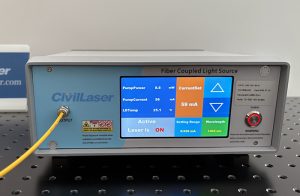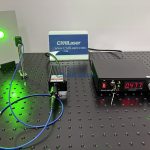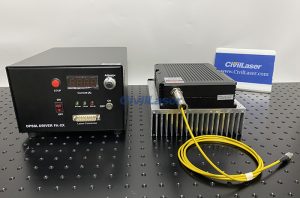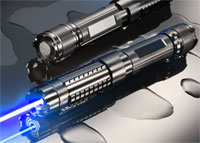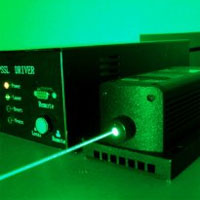Category Archives: Civil Laser
1064nm 15W Semiconductor Laser with Radiator Extend the Working Time
This is a laser system that adjusts the power by adjusting the current. To adjust the current, turn the ‘Adjustor’ knob clockwise, when the current exceeds the min working current, the Laser indicator turns green, and there is laser output. ‘Adjustor’ rotates clockwise to the end, which is the max working current and the max output power of the laser. In addition, the red STOP button is used for emergency stop, and it is not needed under normal circumstances. Let’s check it now.
This is a 1064nm 15W high power infrared laser. An aluminum heat sink is installed under the laser module, which can effectively extend the continuous working time. The radiator is equipped with two cooling fans. There is a small power interface on the side of the data cable close to the laser head for the cooling fan. In addition, the Lock crystal head cannot be pulled out. External signal Mod Input, no need to connect in CW mode. The IR laser supports 3 working modes: CW/TTL/Analog. The above video demonstrates CW working mode.
1064nm is invisible to the human eye. We use an infrared photosensitive film to view the light spot.
Safety reminder:
Wear laser safety glasses when operating high-power lasers.
Laser irradiation of human eyes and skin is prohibited.
880nm 20W Fiber Laser Source NIR Invisiable Laser
This is 880nm 20W high power infrared laser. A fiber coupling interface is added to the laser output port, which can be inserted into a fiber. A cooling device is added at the bottom of the laser module, which is composed of aluminum sheet and cooling fans. The laser supports CW continuous work and modulation work mode, which can be adjusted by the slider button on the back of the laser power supply.
The optical fiber is pluggable, the default fiber interface is FC/PC, and the fiber interface can be customized. The Adjustor button on the power supply is used to adjust the working current, so as to adjust the laser output power. Let’s check it now.
The 880nm laser is a near-infrared laser, basically invisible, only a faint red dot can be seen on the light shield.
1310nm 20mW PM Fiber DFB Laser Source Benchtop
This is a 1310nm 20mW infrared laser coupled optical fiber. The fiber is PM1310 polarization-maintaining fiber, and SMF-28e single-mode fiber can also be customized. In addition, the single-mode fiber coupling interface is a consumable part, we make it into a fixed state and cannot be plugged or unplugged. The power of the laser output can be adjusted by the button, and the adjustment accuracy is 0.1mW. The back of the laser has an RS232 interface, and software control mode can be added.
1310nm single-wavelength laser light source uses DFB semiconductor laser chip, polarization-maintaining fiber output, professionally designed drive circuit and TEC control to ensure the safe and stable operation of the laser.
The test data for a 1310nm laser.
The spectra of the 1310nm laser at 1mW and 20mW respectively.
The test data for a 1310nm laser.
The spectra of the 1310nm laser at 1mW and 20mW respectively.
ASE Broadband Light Source with Two Fiber Outputs
This is a custom ASE broadband light source with built-in circulator. Unlike the standard ASE, this custom ASE has 2 fiber outputs. The two output fibers are the 2nd and 3rd fibers of the circulator. Let’s check it now.
The fiber ASE broadband light source is an incoherent light source, which is the spontaneous radiation generated by the semiconductor laser pumping erbium-doped silica fiber, and the spectral flattening technology is introduced to achieve a broadband flat spectrum. The wavelength of the light source covers the C-band, and the spectral flatness is better than 2dB. It is output through single-mode fiber or polarization-maintaining fiber, which is suitable for applications such as fiber sensing.
CivilLaser can customize various ASE light sources according to customer needs. The wavelength range of C-Band, L-Band, C+L band is optional. Fibers are available in SM and PM. It can be customized whether to add a circulator. The output power can be customized as adjustable power. Software control function can be added. General models are listed on the web page, if you need special customization, please contact us.
Analog Modulation VS TTL Modulation
Analog Modulation VS TTL Modulation
.png)
The default modulation is Analog. (TTL modulation can be customized. )
Analog modulation:
.jpg)
1. Use Analog modulation can adjust the laser output power.
2. We use 0~5V voltage as the analog single.
TTL modulation:
.jpg)
1. High voltage signal turn on the laser power, low voltage signal turn off the laser power.
2. The high voltage is about 3V, The low voltage is about 1V.
How to clean Laser lens , CO2 laser lens cleaning
How to clean Laser lens , CO2 laser lens cleaning
.jpg)
Step1:
Be flexible cleaning against light pollution (dust, fiber particles)
Use a blow balloon, blown off the contaminants which scattered on the surface of the optical element.
.jpg)
Step2:
Be flexible cleaning for slight contamination (stains, fingerprints)
Infiltration a unused swab or cotton balls with acetone or isopropyl alcohol] . Gently wipe the surface of the optical element with a wet cotton, do not force friction. Drag wet cotton on the surface, drag speed control. The stay behind of the wet cotton liquid can be evaporate immediately, so they will not leave marks.
Can only use plain paper body stick cotton swabs, and high-quality medical cotton. We recommend the use of reagent grade acetone or isopropyl alcohol.
.jpg)
Step3:
Be strong cleaning for heavily polluted (splatter) optics
Infiltration a unused swab or cotton balls with acetone or isopropyl alcohol] . Gently wipe the surface of the optical element with a wet cotton.Wipe dry the excess isopropyl alcohol with a clean cotton swab on the optical element.If you removed the thin film coating.the performance of the optical element will be completely destroyed. If the color of the optical element is changed, it means the thin film coating has been removed, you need to replace a new one if the lens coatings damaged.
Comparison of brightness of light spot and beam among lasers of different wavelengths
Comparison of brightness of light spot and beam among lasers of different wavelengths
Some beginners often ask me how much the power of 532nm laser equivalent to the brightness of 445nm laser is
The question may not be so easy to answer, because the sensitive degree of each eye to light of different wavelengths is not the same.
And the feelings will be also different in the dark and light conditions .
Scientists have established light / dark vision functions respectively according to the mean value of human vision in the light / dark environments.
When the brightness is more than 3cd/㎡, it is a photopic vision, and pyramidal cells play a major role, peak value of V(λ)will be between 550nm~560nm; when the brightness is less than 0.03cd/㎡, it is a scotopic vision, rod cells play a major role, peak value of V(λ)shifts to short wavelength, equivalent to blue green parts between 500~510nm. Functions with brightness between 3~0.03 also appear in this position.
First let’s discuss the spot brightness. Spot brightness is basically decided by visual function when the power and density are the same.
The function value of 532nm is very high both in light and dark conditions, so it has relatively high brightness.
While the function value of 445nm is quite different in light and dark conditions, theoretically, the brightness is very low in daytime and has a good effect in night.
But, in fact, we also need to consider the factor of the main light.
For example, observe spots in the sunlight.
This is the power distribution of sun light.
Spot brightness also depends on the difference value of light source.
Just like 445nm, it is in a depressed position of solar spectrum, so it has a obvious contrast that the brightness of observation under sunlight has improved.
Next, let’s talk about the beam brightness.
Beam brightness is not only related with vision function but also has a great relationship with the scattering rate.
Even when they have the same power and beam diameter, because the air scattering rate is not the same, their power density will be different.
Atmospheric scattering is divided into various types, some have a stronger scattering to short wave, while some have basically the same scattering to full waves.
So this has enhanced beam brightness of short wave like 445nm once again, but it has also increased the loss of distant 445nm beam, therefore, 445nm beam often looks bright up close and dark at a distance.
Finally, I would like to remind of the safety of yourselves and others.
Ensure that there is no any personnel near light path or new light path that may be generated by reflection.
We are not recommending to observe laser spot up close with naked eyes without any protection.
Bonding crystal, optical cement crystal, separated crystal
Bonding crystal, optical cement crystal, separated crystal
First introduce the principle of 532nm laser
808nm semiconductor laser diode (LD) of pumping source supplies energy to laser crystal
Most of crystals are Nd:YVO4, some are Nd:YAG, both have Nd3+ ions and can produce 1064nm infrared laser
Infrared laser turns into 532nm green light through KTP nonlinear frequency doubling crystal
So, 532nm has 2 crystals, including laser crystals and frequency doubling crystal, the combination method of these two crystals include bonding, optical cement and separation.
Bonding crystal. UV light adhesives are adopted to bond crystals. If the power is relatively large, the crystals will be heated up quickly, then that would be a tragic if adhesives may come unglued after expansion and contraction. The extreme power of agglutination crystal is 200mw and its stability is poor
Optical cement crystal. A special treatment is conducted to contact surface of crystals (estimated to be highly polished), then crystals will be pressed together, crystals after this treatment will not be easy to come unglued as molecular forces integrate and their stability are relatively high, good for lasers below 300mW
Separated crystal. 2 crystals are separately placed for independent cooling, it can withstand a great power. Its weaknesses is that complex adjustment is needed to change the crystal position to achieve the maximum output and it has complex structure, large volume and high cost.
Laser Spatial mode
Laser Spatial mode
The distribution of light intensity on cross section of laser beam is called laser transverse mode. The transverse mode is generally regarded as the laser mode. TEMmn is used to present transverse mode. TEM means transverse electromagnetic wave, both m and n are positive integers, respectively standing for ordinal numbers of the points with zero light intensity on x axis and y axis, called mode ordinal number. The diagram below shows light spots of several different laser beam transverse modes. TEM00 mode is also called as the basic mode, the light intensity of any point in its spot will not be zero. If there is a light intensity of any point in spot on x axis is zero, it is called as TEM10 mode; If a light intensity of any point in spot on y axis is zero, TEM01 mode, and so on, mode ordinal numbers m and n are larger, there are more points with zero light intensity in spots. Laser beam with different transverse modes is called as multimode.







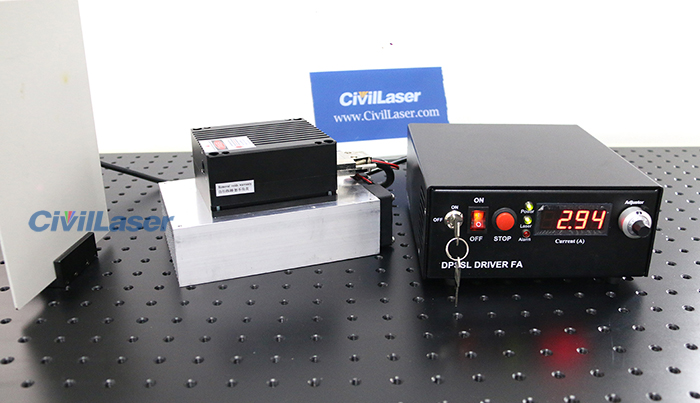
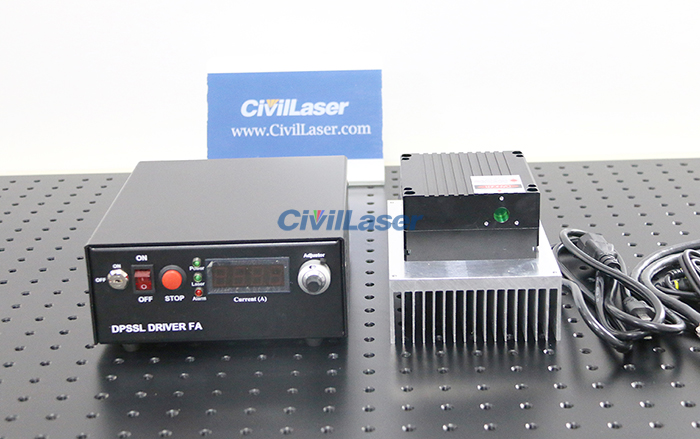

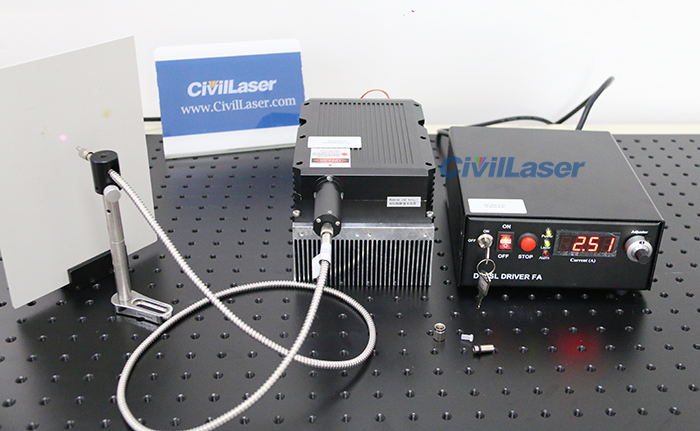
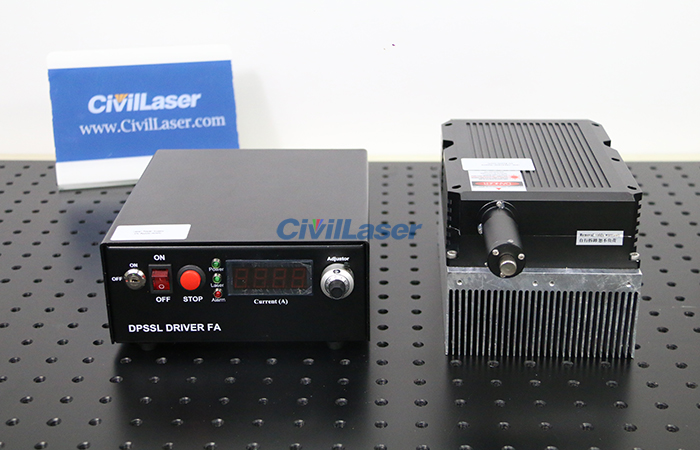
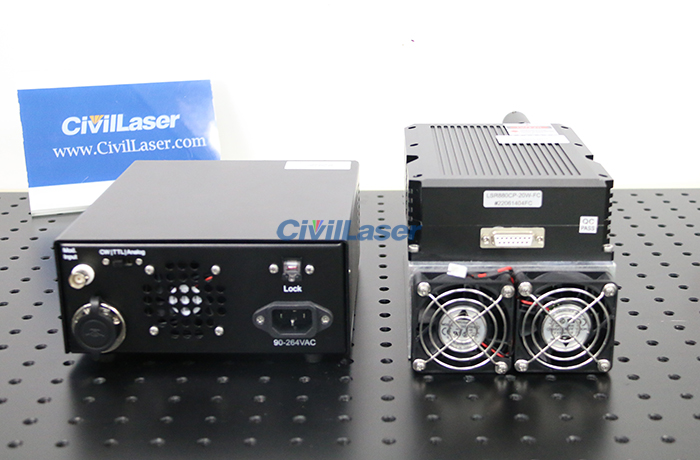
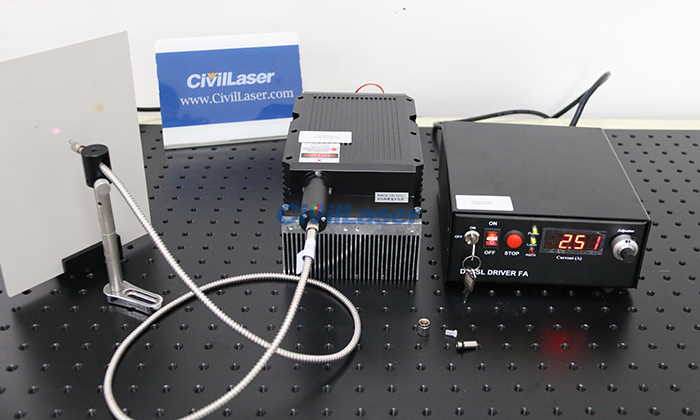
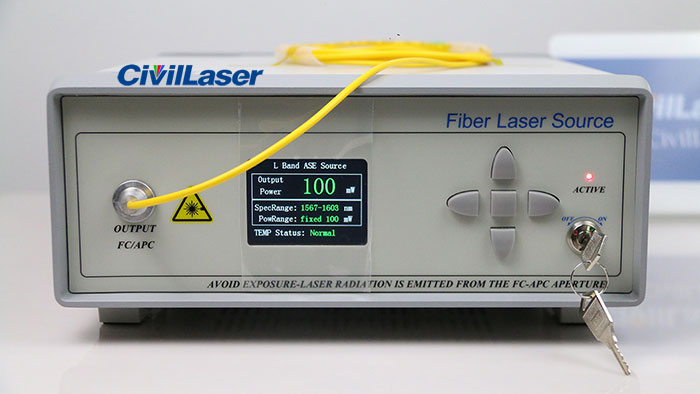



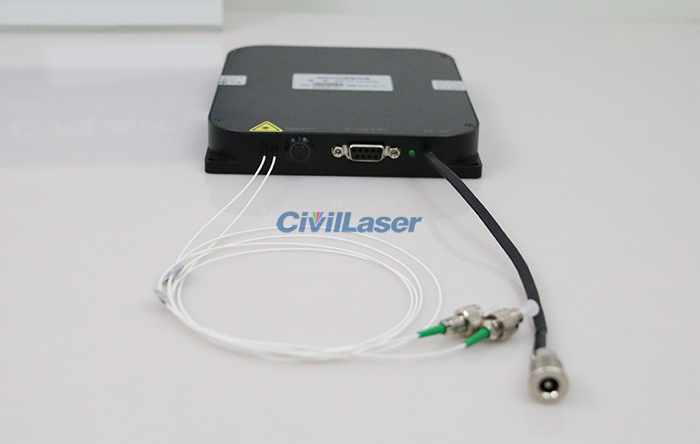
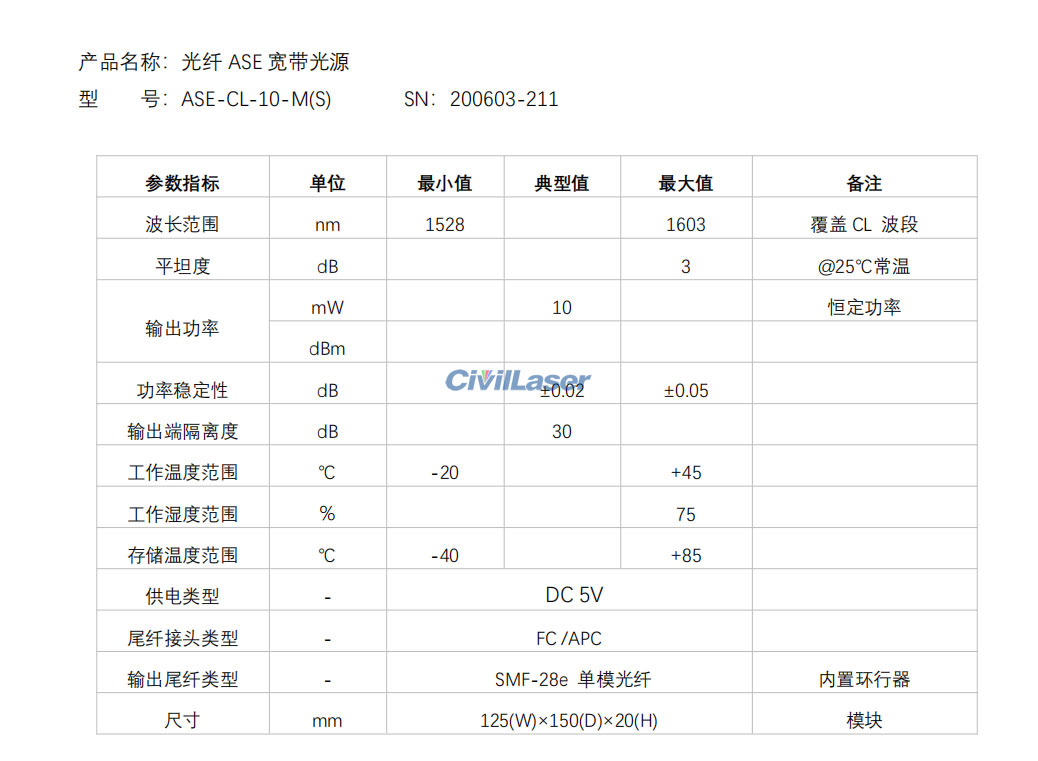
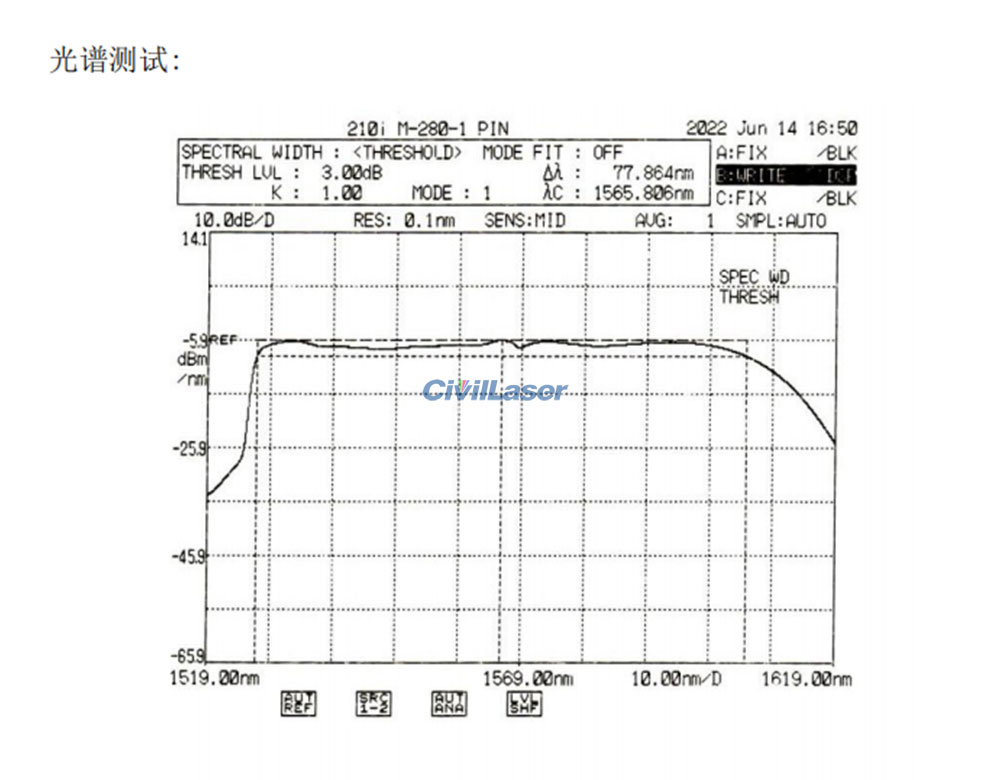

.jpg)
.jpg)
.jpg)
.jpg)

